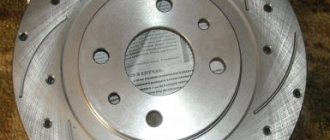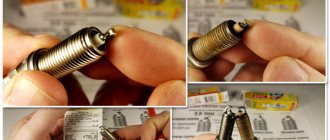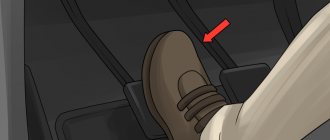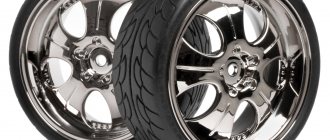Like any other rubber product, car tires have a limited service life. At the same time, the shelf life of rubber is influenced by a number of factors, ranging from natural wear and tear during operation to rubber aging, changes and gradual loss of the declared properties.
As practice shows, the service life of winter tires is shorter than that of summer tires. Moreover, the shelf life of studded winter tires in some cases differs from their non-studded counterparts. Next, we will look at the service life and shelf life of winter tires.
Shelf life of unused tires
It is a fact! If an unused tire is stored in a dry, dark room at a temperature of +15 to +25 C (they are also stored in BlackTyres), then according to GOST standards it will be considered new for 5 years from the date of production and will not age for 3 years.
This happens thanks to additives (anti-aging agents) that are added to the rubber mixture by the manufacturer itself. If you follow all the principles of proper storage, they will retain the beneficial properties of car tires for a long time. After tire installation, the internal pressure will begin to erode the anti-aging agents and begin the process of counting its “age”.
You can understand that a tire has begun to age prematurely by the following signs:
- Significant deformation of the sidewalls;
- Microcracks;
- Gray color with a white coating.
It is better not to buy a bloated gray tire with cracks in the tread. This is unlikely to be a new design, most likely it was simply stored incorrectly for a long time.
Shelf life of winter tires
These tires are made of special winter rubber to be more elastic and not crack in the cold. Because of this, they have a specific shelf life. If the temperature, humidity, and darkness are at the proper level, wheels (both with studs and tires without them) can be stored for up to 7 years without use.
Shelf life of summer tires
The summer tread is tougher in rubber composition than its winter counterparts. Its savings period is much longer than that of winter, but it cannot exceed 10 years in compliance with all possible rules.
Shelf life of all-season tires
All-season vehicles are popular among drivers living in warm climates with mild winters. If the conditions of lighting, humidity and temperature are not violated, the shelf life of these car tires is at least 5 seasons from the date of manufacture.
Methods for determining tire wear
Using summer tires becomes dangerous if the remaining tread height becomes less than 1.6 mm. For winter tires, the standards are stricter - the tread cannot be less than 4 mm. In these cases, the tires should be replaced. Nokian and BridgeStone also have indicators in the form of numbers or snowflakes that will help you determine wear in a timely manner.
In our harsh climate in winter, many people prefer tires with studs. It should be inspected for the presence and condition of thorns. An insufficient number of them prevents the tire from adhering to snow or ice-covered surfaces. Manufacturers claim that if 40% of the studs are missing, the tire loses its quality.
In conclusion, watch a video about tire wear and how many seasons winter tires last.
Tire life
It is a fact!
Once the new tire is on the car's wheels, you can drive it without fear of tread wear for an average of another 5 years. However, the five-year service period is only a convention. What is much more important is not the release date, but the degree of everyday wear and mileage of the tire. It is worth paying attention to the remaining tread depth: for passenger cars weighing less than 3.5 tons it is 1.6 mm, for trucks over 3.5 tons - 1.0 mm, for buses - 2.0 mm, for motorcycles and mopeds - 0.8 mm.
The service life of car tires will begin to steadily decline for several reasons:
- Excessively high tire pressure and high overloads;
- Daily mileage;
- Car suspension malfunctions;
- Aggressive driving (will last 1-2 seasons);
- Driving on bad roads.
However, even with the most careful driving, the maximum service life is 10 years. According to the manufacturers, having crossed this threshold, the tire will lose all its useful properties due to a high degree of wear, and driving with such a tread will become simply dangerous.
The maximum mileage after which it is recommended to change the tire also matters. Its value depends on the type of transport:
- Passenger cars with a carrying capacity of up to 2 tons – 45 thousand km.
- Trucks 2-4 tons - 60 thousand km.
- Trucks over 4 tons – 68-70 thousand km.
Beware - a myth! They say that car tires of different batches have different service periods and wear resistance, which means the production date can also cause a defect even with low mileage. But the truth is that the composition of raw materials and technology are the same for everyone, and it doesn’t matter where in the world the industry leader opened his next plant. The operational requirements are the same both in Germany and in Taiwan.
Service life of winter tires
When the car does get new “shoes”, it is worth considering that the service life of winter tires differs depending on the type of winter tires:
- Friction (“Velcro”) will last up to five seasons if driven carefully and without extreme wear.
- Studded tires will last an average of 3-4 seasons, again if their driver does not want to regularly check the tread for strength during steep turns and off-road conditions.
Lifespan of summer tires
Summer treads are created more rigid than elastic and soft winter ones, and therefore the service life of tires with the most careful driving of a car on a flat road surface is on average 5-6 years.
Service life of all-season tires
The wear rates of car tires greatly depend on the climate in which the trips take place, but when driving in European winters and hot summers, all-season tires “live” on average 3-4 years.
Factors affecting tire wear
The wear of car tires is influenced by many factors : country of manufacture, mileage, operating and storage conditions. Let's list the main ones.
Storage method
stored in a cool, dark and dry place. Too high temperatures, humidity and sun are detrimental to rubber products. Tires on rims should be stacked for storage, and empty tires should be stacked vertically next to each other.
Tire pressure
Check the tire pressure regularly - low levels negatively affect the service life. Also, do not overinflate your tires; when using a pump, be sure to check the result with a pressure gauge. For the winter period, the pressure is 0.2 bar higher.
A tire pressure reduced by 2 bar increases the braking distance by 1.5 times.
You can find out the correct values from the following table.
Driving style and bad roads
For a long service life of car tires and minimal wear, you should adhere to the following rules:
- Drive at an average speed - no more than 90 km per hour. This will extend the life of studded tires by 40% compared to driving at speeds over 120 km per hour.
- Try to move smoothly, without jerking or slipping. Don't brake too hard, as you can quickly burn your tires. Fans of drifting are also “golden” clients of car dealerships in terms of the amount of tires they burn.
- There are two problems in Russia, and one of them – bad roads – the state has been actively fighting for many years. The quality of the road surface directly affects tire wear. But here we are still powerless.
- Do not overload the luggage compartment. This leads to uneven load distribution, which increases tire wear.
Wheel imbalance and wheel alignment
Another danger to tires is unbalanced car wheels. This also increases the wear rate of the rubber. When changing tires from winter to summer and back, be sure to balance the wheels.
Also, due to toe imbalance, the car loses control and is pulled to the side, which can lead to an accident. To avoid such problems, have your wheel alignment adjusted in a timely manner at a car service center.
From theory to practice
Enough has already been said in theory about what the service life and shelf life of tires are. Now let's talk about whether it's worth bothering yourself with these numbers when going to the store. Lately, the issue that tires need to be checked almost like milk cartons has been raised more and more often and only confuses buyers.
The first thing to keep in mind: in the warehouse of a large online store (including BlackTyres) tires are in constant circulation. It is extremely difficult to sort them depending on the service period due to the fact that storekeepers ship thousands of items every day, and order delivery points accept mixed batches. There are very rare cases when they will be determined by year - usually in the off-season, or when a large batch has arrived from the factory, but they will be stored in common cells.
Second: we have tires in our warehouse that are 4-5 years old after manufacture. They are sold along with the “young ones”, since people often drive older models, change them 1-2 times a year and do not complain. However, if the client is concerned about the expiration date, he will be given a letter of guarantee that we take responsibility for the occurrence of warranty cases.
And finally, the last and most important: in all modern enterprises, tires are produced mainly by robots on high-precision equipment using the same technology, with the same composition of raw materials. Therefore, there is no difference between products that were released three years apart, if the storage rules were not violated.
Period of use of tires with studs
Typically, manufacturers consider the shelf life of winter tires to be a five-year warranty period. It takes a report from the date of manufacture (not sale) of rubber and can be the same or exceed the resource (real period of use) of tires, which is often determined by the country of manufacture:
Example of a tire series
- European wheels (winter season) usually last approximately 50,000-60,000 km.
- Domestic tires for a car - 20,000-40,000 km.
- Chinese tires on cars - 50,000-80,000 km.
We can conclude: even new inexpensive economy class tires, if used correctly, will not wear out in 2 seasons. Next, the car owner must independently monitor the condition of the tires.
Those motorists who cannot choose between “studded” or “Velcro” should recommend studded wheels under other equivalent conditions. As practice has shown, they last a little longer (their approximate resource is 30,000 km) than friction rubber.
The date of creation is always marked on the product. The less tires were stored in a warehouse, the longer they can be used.
This most comfortable system dates back to 2000. The initial 2 digits are the week the tire was manufactured, and the final two digits are the year. There are other ways to find out the date of creation of tires for a vehicle.
In order not to calculate the days and not make a mistake, this work can be “transferred” to an automatic service. To do this, you should use a unique service, a virtual calculator, of which the Internet offers a lot. The services work quite simply: the car owner enters the final 4 digits of the series located on the product into a special field of the calculator. In response to these actions, the car owner will see information on the screen about the date of creation of the tire.
Drivers will also be interested in knowing how to decipher a three-digit code, a code with stars and other options.
Operation when wear level is exceeded
Many car owners know about the residual wear level set for winter tires - 4 mm. That is why, when this value is reached, such wheels continue to be used during the warm season.
Tire tests show that even after a year of operation, the braking properties of tires are reduced by 10%. And almost bald winter tires on summer asphalt are simply unsafe. The risk of a road accident increases many times over.
- 5
- 4
- 3
- 2
- 1
(18 votes, average: 4.1 out of 5)
Best regards, Maxim Markov!
Adblock detector
Signs that a tire has become unusable
If summer tires should be changed when the remaining tread height has reached 1.5 mm, then with winter tires everything is much stricter. The maximum value in this case is 4 mm. After this, the tires must be urgently replaced.
More advanced manufacturers like Nokian and Bridgestone build an indicator into the rubber in the form of numbers or snowflakes that show actual wear.
Bridgestone tires allow you to understand the level of wear
When answering the question about the service life of winter studded tires, do not forget about the studs themselves. If 40% of metal elements are missing, the wheels are considered vulnerable. If the sockets in them are not loose, you can carry out studding yourself. Otherwise, the product can be safely thrown away.
It is also possible to check the validity of tires using a penny coin. In ideal condition, the protector should cover the inscription completely; on average, only part of the inscription and the design underneath it are covered. A replacement is urgently needed if the protector only covers the edge of the coin.
How many seasons does a tire last?
If the outer edges show more wear than the center of the tread, your tires are under or over-inflated. And not equally worn tread edges exclusively on one side alert the driver to wheel alignment problems. In addition to wear, how long tires last is also influenced by how you drive your car. For extreme sports enthusiasts with sharp brakes, the tread will wear out faster. It becomes clear that durability is affected not only by the type of car race the wheels are suitable for, but also by other factors:
- driving style;
- road quality;
- participation in emergency situations.
Storage period for tires for cars without use
According to GOST, it is 5 years, but this does not mean that they will be unsuitable.
What is more important here is how they were stored all this time. When changing from summer to winter or vice versa, an unused set must be kept in appropriate conditions so that it will last for more than one season.
Storage conditions
If tires are stored without rims, they are placed on the tread. If on disks, they need to be hung or stacked on top of each other. To maintain elasticity, you will need to lubricate with a special tire care product.
Where is better
A warehouse without a source of direct sunlight, exposure to ozone, or mineral oils is ideal for this purpose. It should be well heated (from +10 to +35 °C), and the humidity should be maintained at a normal level (~ 80%).
Running in winter studded tires
Any car tire must travel up to several hundred kilometers before the level of its strength and road grip reaches the figures stated by its manufacturer. In the case of summer car tires, they are ready after 100 km of average driving. Winter tires require a scrupulous break-in process. Studded tires need to be rolled in more carefully than friction velcro tires. As you can see, running in studs is the most important and complex process; its process must be approached with maximum responsibility and care.
Winter spike
Winter tires, as a rule, begin to break in in advance, even before the onset of winter frosts, snowfall and ice formation on the roads, most often this is done several days in advance. Each car owner can independently track the approximate beginning of winter in his region based on annual observations and weather forecasts.
A few days before the onset of stable winter weather, you should change your tires and start running them in.
Fine
It’s no joke, but as of 2022 there is no punishment for violating clause 5.5 of the Technical Regulations, just as there are no fines, no deprivation of rights, or other types of punishment for any non-compliance with this regulatory act. The current Code of Administrative Offenses simply does not provide for such.
The only fine in the amount of 500 rubles or even a warning can be issued for violations of the operating conditions of vehicles according to traffic rules under Part 1 of Article 12.5 of the Administrative Code. But these two regulatory documents should not be confused - the obligation to change shoes is not stated anywhere, and driving on spikes in the summer is in the regulations; in the Rules there was not a word about the seasonality of using rubber.
You can check the current version of all traffic police fines yourself by searching, and you will not find here a single sanction that would be applied for violations of regulations, as well as GOSTs, in force in Russia.
Expert opinion
Yuri Panchenko
Driving instructor, human rights activist, author of books. 10 years of experience.
The Technical Regulations of the Customs Union on the safety of wheeled vehicles contain all the requirements for all vehicles that are produced and operated on the roads of the Russian Federation.
Unfortunately, since its adoption, the corresponding amendments to the traffic rules have not been adopted. The result is a legal conflict: on the one hand, malfunctions for which operation is prohibited are listed in the Basic Regulations for Permission to Operation, and no one has been looking into this list for years. On the other hand, a similar, but more complete list is contained in the technical regulations.
Today, alas, the operation of a car is punishable only with those faults that are given in the Basic Provisions for Admission. Therefore, there is no penalty for driving a car with winter wheels in the summer and with summer wheels in the winter, and, apparently, it will not appear soon. And therefore, drivers continue to drive on the roads, risking not only their lives, but also the lives of those around them.
Ask a Question
Increased service life
The guaranteed service life of studded winter tires or classic tires can be extended without compromising the safety of passengers and other road users. Installation is carried out under the conditions of an authorized service station. Its employees rely in their work on the recommendations of the car manufacturer. The operating instructions list the requirements that must be met. Attempts to install it yourself will lead to damage, for example, to the cord layer. The expiration date of winter tires and studs are selected, taking into account the weather conditions in the region. The more often the weather shows a harsh temperament, the higher the requirements for the manufacturer. A qualified service station employee will provide invaluable assistance.
The installation is followed by balancing, which is carried out using computer equipment. Safe use of winter studded tires is only possible with an even load on each wheel. If there is a imbalance, then problems will not keep you waiting. List of other recommendations, compliance with which will extend the service life:
- Constant control of pressure level. The check is carried out at least once every 15-20 days. An increased level of pressure provokes the internal surface, and a lower level threatens the external part.
- Maintaining a sanitary condition - the actual period of use of winter studded tires depends on the prompt removal of traces of oil, dirt, and foreign objects.
- Visual inspection - the problem is eliminated as soon as the first symptoms are recorded. A small cut or chip requires immediate attention.
- Balancing – Severe weather conditions have an increased impact. At least once a month he comes to the service station to carry out computer monitoring of the condition of the wheels.
- Storage rules - at the time of purchasing wheels, it is worth checking whether the seller followed the recommendations of the wheel manufacturer or not. Each type of rubber is stored at a certain temperature. If the seller or the owner of the wheels violated the rules, then problems will make themselves felt. Store shoes at a temperature of +24 - + 25 °C. The ventilated area should have a moderate level of humidity.
The car must have a spare tire for quick replacement. Despite the fact that the shelf life of winter studded or studless tires can be long, you need to be prepared for various situations.
On a note! When the tires are replaced, the valve is changed. The driver checks the degree of its tightness.
Law on changing tires to “summer” from March 2022
However, a number of media outlets are disseminating incorrect information about the obligation to switch to summer tires as early as March 2022, citing local legislation as the reason for this rule.
But, as we mentioned above, no local laws have been adopted. You can check this, for example, by requesting an official comment through the traffic police online reception and selecting your city (region) in the address field.
And since April?
And in this case, too, there is no new law that would oblige one to change tires to summer ones in April of this year. The procedure for setting “winter” to “summer” today is regulated only by the consciousness of citizens, since driving on studs in wet weather is more dangerous than driving on summer tires.
Moreover, according to the law, there is no need to change tires in May 2022. As we have already commented above, only from June it is forbidden to ride on studded wheels.
How many years can it be used?
Tire cracks
If tires are used correctly, their service life can reach 100,000 km - a car mileage that, according to statistics, will take the driver approximately 4 years to cover. Experts advise assessing the condition of the tires with studs at the end of the winter season. If more than 50% of the elements are in place, this means that the tires will last another season, but if they are not enough, you can move on wheels throughout the summer until they are completely worn out, after which you should purchase new wheels.
What does wear depend on?
The suitability and wear of tires can be influenced by various factors: from the country of manufacture, mileage and conditions of use to storage method. Let's take a closer look.
Pressure
An insufficient number of atmospheres has a negative effect on rubber and its service life is reduced.
It is also not recommended to overinflate the wheels. This can lead to uneven wear. The optimal pressure in winter will be 1.6 - 2.6 bar. The exact number of atmospheres depends on the type of car and is indicated in the operating manual.
Tire pressure must be optimal to extend tire life.
Driving style and bad roads
To ensure long-term operation of car tires, you must:
- Do not exceed the average recommended speed of 90 km/h. This will preserve studded tires 45% better compared to driving at about 120 km.
- Movement along the highway should be smooth; it is recommended to avoid sudden jerks and slipping. You need to brake smoothly so as not to burn the rubber on the asphalt.
- The road surface and its quality play an important role in wheel wear. But ordinary drivers have little influence on this factor.
Interesting! It is important not to overload the trunk. This will help avoid uneven distribution of load on the tires.
Tire alignment
An equally significant danger for winter tires is imbalance. It significantly increases tire wear.
Imbalance will help you find out about many problems with the car.
When replacing summer tires with winter ones, do not forget to balance them. Its absence negatively affects the vehicle's handling, which can cause the car to pull to the side.
Timely alignment adjustment at a car repair shop will help avoid problems.
What the manufacturers say
Rubber for vehicles, like other rubber products, wears out. Innovative mixtures of unique ingredients reduce this process, but with prolonged use, microscopic cracks are likely to develop in the tread pattern and sidewalls of the tires, which often come with deformation of the carcass structure, and this will confirm wear.
Safe operation of rubber is usually valid for 6 years from the date of issue. Guarantees service life within a ten-year period. Many brands adhere to a period of 6 years, provided that the rubber is not damaged.
In addition, it is very important to distinguish products by category. It is clear that tires marked ZR (more than 240 km/h), when used at the speed limits allowed for them, are subject to more serious overloads than tires of category S (up to 180 km/h). High-speed products with the H index (up to 210 km/h), in order to create driving safety, should be used for no more than 6 years. For residential car trailers (which often sit for a long time with reduced tire pressure and have low mileage), even perfectly preserved tires should also be replaced after 6 years, rarely - 8. This is also true for well-preserved tires. Determining the age of a product is quite simple.
You need to take separate rims for tires, since each re-adjustment significantly reduces the period of use of tires. In addition, in winter the discs should already be prepared for the summer, so that there is no rush in preparation in the spring.
The manager of a specialized store will help you choose a quality product. If you follow the advice of experts, your tires will last longer and you won’t need to change them ahead of schedule.
Source
Tire marking
This is complete information about tires in one place. It is standard; dimensions, technological characteristics, and features are indicated on the side.
What to look for when purchasing
When purchasing, you need to look at the following characteristics:
- Is the type and size suitable for a particular car? These specs look like 195/65R15, where:
- 195 – profile width in millimeters;
- 65 – percentage ratio of profile height and width;
- R – radial cord;
- 15 – disk diameter in inches.
You can learn about the needs of a specific machine from technical documents.
- Speed and load. For example, 98W means: 98 – load per wheel (kg). W – maximum speed (km/h). Decodings are indicated in special tables common to the whole world.
- Brand, date of manufacture. After the manufacturer's letter designation there are four numbers - this is the week and year of manufacture.
- Seasonality. The summer one is marked with the image of the sun, the winter one – with snowflakes.
How to identify expired tires
You need to find the production date and add 5 years to it. You also need to stock up on measuring instruments and assess the degree of tread wear. The residual height of 2-3 mm will be critical for summer, and 4-6 mm for winter.











